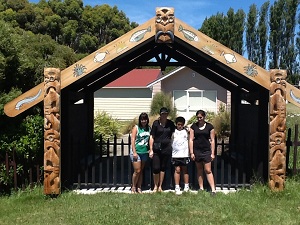The Last Maopo
Feb 28, 2014

L – R, Riana Pearson, Tania Simpson, Hawaiki Te Ruki and Ariahuia Te Ruki outside Ngāti Moki Marae.
A rare account of a Māori soldier’s experience of the First World War will be launched at Ngāti Moki Marae, Taumutu on ANZAC Day, to coincide with the 100th anniversary of WWI.
“The Last Maopo,” is the story of Lance Corporal Wiremu Kaihau Maopo, who joined the 2nd Māori Contingent in the First World War. The book is written by Wiremu’s great-granddaughter, Tania Simpson (Ngāi Tahu, Ngāpuhi, Tainui), of Hamilton, who carries on a line of the family Wiremu never knew he had.
Wiremu was one of thirteen children born to Te Maiharanui Maopo and Ani Wira of Taumutu. When he left for the war, only his father and one sister had survived the disease that decimated the family; but by the time he returned home three-and-a-half years later, they had passed on too, leaving him to think he was the last survivor of his family. He was unaware during and after the war, that his Pākehā girlfriend, Phoebe Prentice had given birth to a daughter, who would carry on his line.
“The Last Maopo” follows Phoebe’s story and retraces Wiremu’s life in a tale of hardship, prejudice and endurance that spans New Zealand and the Western Front. It includes more than 40 letters that Wiremu wrote during the war to his friend Virgie Fincham. Those letters, kept for many years by Virgie Fincham, were passed on to her niece, who found a good custodian for them in the Ellesmere Historical Society.
“A member of the society, Dr Garth Cant, had heard through Dr Terry Ryan that I was reconnecting with my Taumutu whānau and he let me know about the letters,” says Tania.
Tania says the letters alone represent a significant account of Māori service in World War I.
“There’s not a lot of information about the Māori war experience in the public domain. There’s a small amount of well-traversed material but not a lot of new material emerges.”
She says they are of particular interest to Taumutu and Ngāi Tahu whānau – and to historians.
“They give a clear insight into the Taumutu community in the early 20th century – into the closeness of the Māori-Pākehā community and the strong friendships between them.
For Tania, the long journey to discovering her identity has been immensely rewarding.
“I’ve had a huge amount of help along the way though; it hasn’t just been one person’s journey. It’s been a group effort and many people – especially the Taumutu people – have helped me along the way,” she says.
“Knowing these people and their history is also about knowing yourself. We are living repositories of our ancestors and this knowledge helps me understand myself better.”
Tania is the CEO of the Māori development company, Kōwhai Consulting, deputy chair of Landcare Research New Zealand and is a member of the Waitangi Tribunal, and she has written several works on tribal history. The launch of “The Last Maopo” at Ngāti Moki Marae is the culmination of more than twenty years of questioning.
